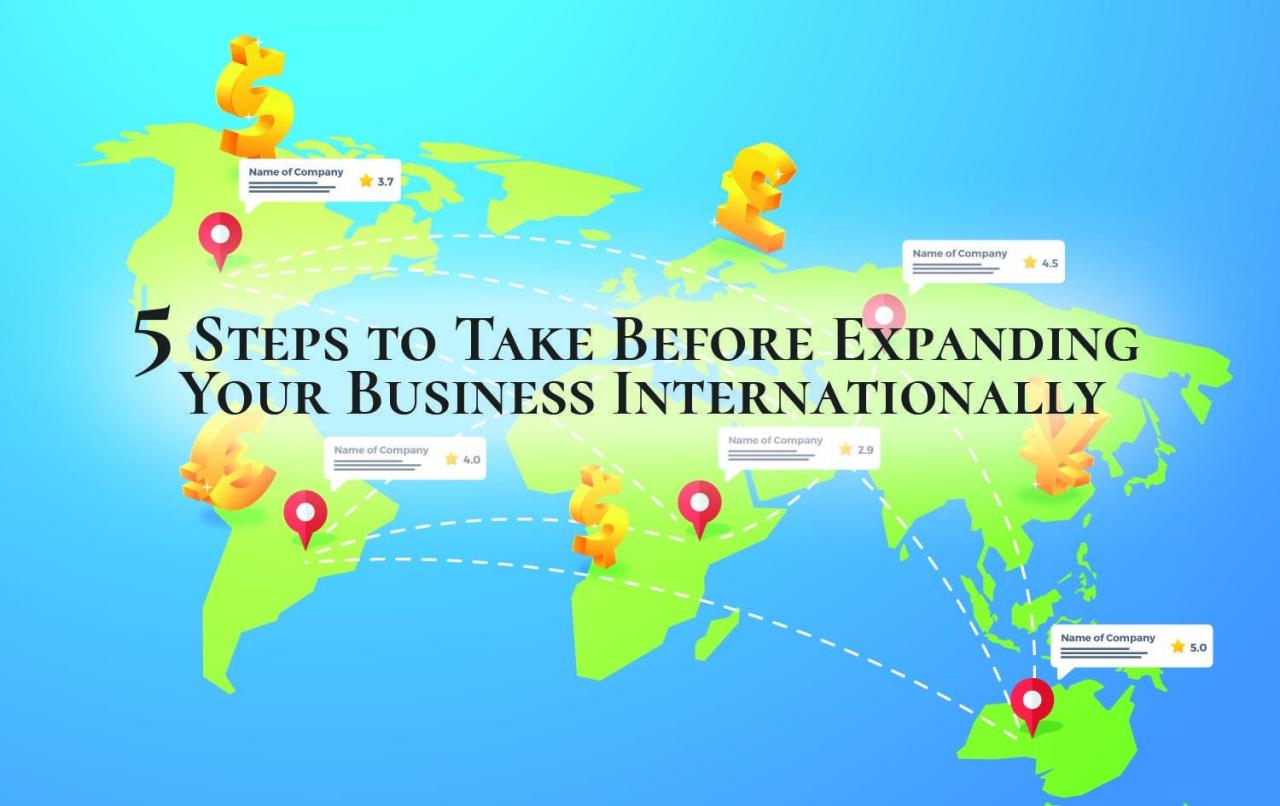How to Expand Your Business into International Markets: A Comprehensive Guide

Embarking on the journey of expanding your business into international markets opens up a world of opportunities and challenges. This guide will walk you through the essential steps and strategies required to succeed in the global business landscape.
As we delve into the intricacies of market research, legal considerations, market entry strategies, global marketing, and international operations, you will gain valuable insights to navigate the complexities of expanding your business globally.
Researching International Markets
When expanding into international markets, it is crucial to conduct thorough research to ensure success. This involves identifying potential target markets, analyzing market trends, consumer behavior, and cultural differences that may impact business operations.
Identify Potential Target Markets
Before expanding globally, businesses need to identify potential target markets where their products or services will be well-received. Factors such as economic stability, political environment, competition, and demand for the product should be considered.
Analyze Market Trends and Consumer Behavior
Understanding market trends and consumer behavior in different countries is essential for a successful expansion. This includes studying purchasing habits, preferences, and attitudes towards specific products or services in the target market.
Compare Cultural Differences
Cultural differences can have a significant impact on business operations in international markets. It is important to compare and contrast cultural norms, values, communication styles, and business practices to adapt strategies accordingly and avoid misunderstandings.
Legal and Regulatory Considerations
Understanding international trade laws is crucial for businesses looking to expand globally. These laws govern the movement of goods, services, and capital across borders, and failing to comply with them can result in hefty fines or even legal action.
Obtaining Permits and Licenses
Expanding into international markets often requires obtaining necessary permits and licenses to operate legally in a foreign country. This process can vary significantly depending on the country and industry, so it's essential to research and understand the specific requirements before expanding.
- Identify the specific permits and licenses required for your industry and target market.
- Consult with legal experts or local authorities to ensure you have all the necessary documentation in place.
- Submit applications and comply with any additional requirements to secure the required permits and licenses.
Compliance with Tax and Customs Regulations
Complying with regulations regarding taxes, tariffs, and customs duties is essential for smooth international operations. Failure to adhere to these regulations can lead to delays in shipments, additional costs, and potential legal issues.
- Understand the tax laws and regulations of the countries you are operating in to ensure compliance.
- Consult with tax experts to determine the tax implications of your international expansion.
- Stay informed about changes in customs regulations to avoid any unexpected issues at the border.
Developing a Market Entry Strategy

When expanding your business into international markets, developing a solid market entry strategy is crucial for success. This involves carefully considering different market entry modes and selecting the one that best fits your business and the target market.
Market Entry Modes
- Exporting:This involves selling products or services to a foreign market directly from your home country. It allows for low financial risk and control over operations.
- Licensing:Involves granting a foreign entity the rights to produce and sell your products or services in exchange for royalties. It can be a quick way to enter a new market.
- Joint Ventures:Partnering with a local company in the target market to establish a new entity. This can provide access to local expertise and resources.
Advantages and Disadvantages
- Exporting:Advantages include low financial risk, full control over operations. Disadvantages may include limited market presence and potential trade barriers.
- Licensing:Advantages include quick market entry, minimal investment. Disadvantages may include loss of control over product quality and brand image.
- Joint Ventures:Advantages include access to local expertise and resources. Disadvantages may include conflicts with partners and shared profits.
Market Entry Plan
To design a market entry plan tailored to the target market's characteristics, it is essential to conduct thorough market research and analysis. Consider factors such as cultural differences, regulatory environment, competition, and consumer behavior. Develop a detailed plan that Artikels your objectives, target market segments, marketing strategies, distribution channels, pricing, and promotional activities.
Adapt your plan to the specific needs and preferences of the target market to maximize your chances of success.
Building a Global Marketing Strategy

When expanding your business into international markets, a solid global marketing strategy is essential for success. This strategy involves understanding the key elements necessary for effective global marketing, adapting products or services to meet the needs of diverse international markets, and implementing communication and branding strategies that resonate with different cultural settings.
Key Elements of a Successful Global Marketing Strategy
- Market Research: Conduct thorough research to understand the target audience, competitors, and cultural nuances of the international markets you are entering.
- Localization: Adapt your products or services to meet the specific needs and preferences of each market, including language, packaging, and features.
- Brand Consistency: Maintain a consistent brand image across all markets while tailoring messaging to resonate with local audiences.
- Digital Marketing: Utilize online channels such as social media, search engine optimization, and targeted advertising to reach global customers effectively.
- Partnerships: Collaborate with local businesses or influencers to establish credibility and gain traction in new markets.
Adapting Products or Services for International Markets
It's crucial to customize your offerings to align with the preferences and cultural norms of the target market. This may involve adjusting product features, pricing, packaging, or branding to better appeal to international customers. By understanding the unique needs of each market, you can tailor your products or services for maximum success.
Effective Communication and Branding in Diverse Cultural Settings
- Cultural Sensitivity: Be mindful of cultural differences in language, symbols, and gestures to avoid misinterpretation or offense.
- Transcreation: Translate marketing materials and messages effectively, taking into account linguistic nuances and cultural references for better engagement.
- Local Partnerships: Collaborate with local agencies or consultants to navigate cultural nuances and ensure your communication resonates with the target audience.
- Storytelling: Use storytelling techniques that are relatable and culturally relevant to connect with consumers on a deeper level.
- Feedback Mechanisms: Encourage feedback from international customers to understand their preferences and adjust your communication strategies accordingly.
Managing International Operations
When expanding your business into international markets, managing international operations is crucial for success. This involves strategies for handling cross-border logistics, establishing partnerships, and navigating economic challenges.
Managing Cross-border Logistics and Supply Chains
Managing cross-border logistics and supply chains requires efficient coordination and communication to ensure smooth operations. This involves:
- Utilizing technology for real-time tracking of shipments
- Partnering with reliable international logistics providers
- Implementing inventory management systems to minimize delays
Establishing an International Network of Partners and Suppliers
Building a strong international network of partners and suppliers is essential for sourcing quality products and services. This can be achieved by:
- Conducting thorough due diligence on potential partners
- Creating mutually beneficial agreements to foster long-term relationships
- Maintaining open communication channels to address any issues promptly
Navigating Currency Exchange Rates and Economic Fluctuations
Dealing with currency exchange rates and global economic fluctuations is a common challenge in international business. To navigate these challenges effectively, consider:
- Hedging currency risks through financial instruments
- Diversifying your revenue streams across multiple markets
- Monitoring economic trends and adjusting strategies accordingly
Last Word

In conclusion, expanding your business into international markets demands meticulous planning, adaptability, and a deep understanding of diverse cultures and regulations. By implementing the strategies Artikeld in this guide, you can position your business for sustainable growth and success on a global scale.
Helpful Answers
What are the key factors to consider when researching international markets?
When researching international markets, it's crucial to identify potential target markets, analyze market trends and consumer behavior, and compare cultural differences that may impact business operations.
How can a business navigate challenges related to currency exchange rates and global economic fluctuations?
Businesses can navigate such challenges by implementing risk management strategies, hedging against currency fluctuations, and staying informed about global economic trends.
What are the main components of a successful global marketing strategy?
A successful global marketing strategy includes defining key elements, adapting products/services to meet international market needs, and effectively communicating and branding in diverse cultural settings.

